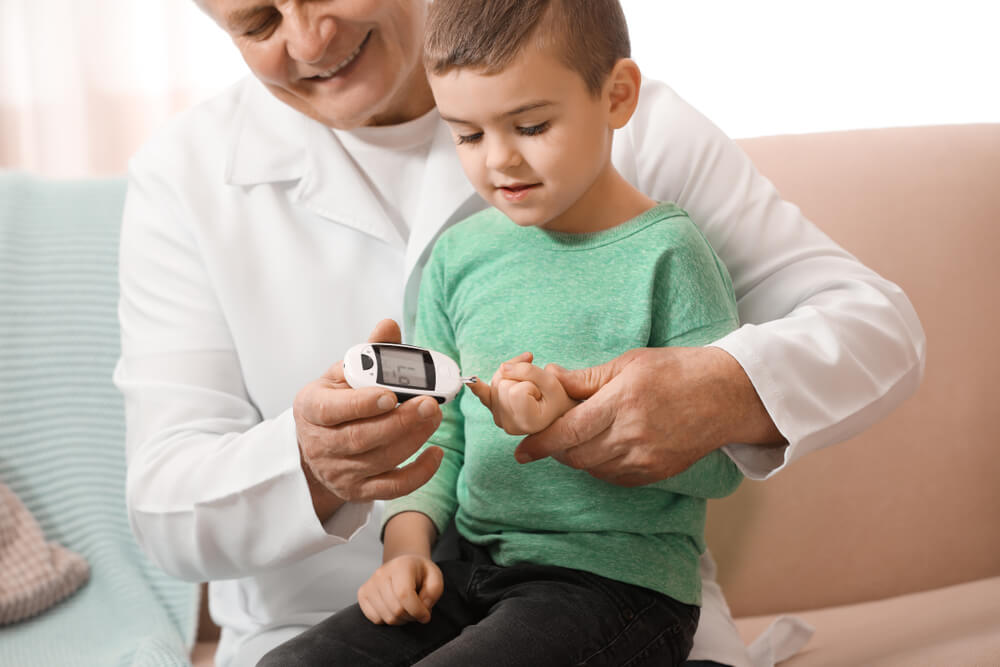Always being aware of their blood sugar level makes it much easier to pick up the first signs of diabetes in kids and in toddlers: if you don’t know there’s a problem, you can’t help before it becomes an emergency. Fortunately, it’s easy to stay on top of kids’ blood sugar – all you need is a home glucose (blood sugar) meter. Keep on reading to find out how this works and to learn more about what is and what is not normal blood sugar for kids.
Also, if you are looking for pediatric diabetes specialty services, we can help you find the best treatment for your little one.
How To Check Your Child’s Blood Sugar Level
– Start by washing both your own and the child’s hands with water and soap and dry them properly with a clean towel. Before taking the blood sample, check again that the finger you want to draw blood from is dry because a wet finger might affect the results.
– Prick the side of the kid’s fingertip. With some types of meters, you can also prick the forearm. Rather use a finger, however, when the child’s blood sugar level is changing rapidly, e.g., after exercise or meals, or you expect a low blood sugar reading.
– Insert a strip into the glucose meter
– Draw a drop of blood from their finger
– Apply the blood to the test strip
– Get a reading and make a note of the test results. Modern meters only take a couple of seconds before the result is shown on the screen
– Use a clean cotton ball to apply pressure to the area where you drew blood to stop the bleeding
– Take the logbook with you every time you bring your child to the doctor. He or she will know exactly what normal blood sugar for kids should be and what the first signs of diabetes in kids are.
When To Check Kids’ Blood Sugar

These are the best times to test your child’s blood sugar level:
– If there is any reason to suspect that they have an unusually low blood sugar level
– When he or she is ill
– Before and after they exercise
– Before meals
– Before they go to bed
– If the test results from before the meal do not match, test again two hours later
– At night. This is especially important if their blood sugar level tested unusually low during the day, he or she was feeling ill, there was a change in their insulin dose, or they exercised more than on an average day. Sometimes your kid might need a blood sugar test in the middle of the night. This will, for example, be necessary if they regularly have hypoglycemia episodes. Children who have recently shown signs of diabetes might also need more regular tests. The same applies if your very young child showed symptoms of diabetes in toddlers.
What Is The Normal Blood Sugar Level For Kids?
The Nationwide Children’s Hospital Diabetes Center has published the following target blood sugar levels for kids. Please note that kids’ blood sugar levels should be kept within these limits most of the time. The odd exception should normally not because for alarm as long as it tests within the accepted range again within a relatively short time.
- From 0 to 5 years old: Between 100 and 180 mg/dl
- From 6 to 9 years old: Between 80 and 140 mg/dl
- 10 years or older: Between 70 and 120 mg/dl
Your child’s doctor or pediatrician will be able to recommend a personalized blood sugar target range for them. Generally speaking, the aim is to get blood sugar levels within the normal range with no frequent high or low spikes. Research indicates that regular, extremely low test levels in kids younger than six could result in neuron-cognitive problems, i.e., it could negatively affect the child’s intellectual abilities.
In the case of adolescents, the targets are similar to those for adults. Maintaining these targets might, however, sometimes be rather difficult because of their higher levels of growth and other hormones.
Preventing Your Child From Getting Sore Fingers From Blood Sugar Tests
Sore fingertips from regular blood sugar tests are fairly common and could become quite painful. Below are a couple of suggestions that will reduce the discomfort.
– Do not squeeze the kid’s fingertip. If you have a problem getting a big enough amount of blood to cover the strip’s test area, let the child’s hand hang down below their waist for at least 5 seconds. Then begin squeezing the finger from which you want to draw blood, starting close to the hand and slowly moving outward until you’ve reached the end of the finger.
– Do not prick the tip of their finger. If you do this, it will make the prick significantly more painful – plus, you might not get a sufficient amount of blood for an accurate test. Rather prick the side of their fingertip.
– Try using a different type of device. With blood sugar meters that use a lancet device, you will be able to also draw blood samples from the leg, forearm, or hand.
– Try using a different lancet. There are nowadays lancet devices on the market that can be set to prick one’s skin lightly or deeply, depending on how thick the skin is and the area where you are drawing blood from.
– Do not use the same finger all the time. Instead, follow a systematic approach by starting with a specific finger and then working your way through all of them. This will ensure that you don’t prick some fingers more often than others.
– Never use a lancet more than once. A used lancet can become infected with bacteria that could make the child very sick. Use a new one every day.
Alternative Technologies For Testing Blood Sugar Levels

The latest technologies make it even more of a breeze to check blood sugar levels for kids, including toddler blood sugar levels. These have also made it easier to pick up early signs of diabetes in kids, including symptoms of diabetes in toddlers. Adjustable lancets, for example, can remove most of the pain from finger pricks because you can set how deep the needle will go into the skin. Some modern meters can even draw blood from the forearm, leg, or hand where the skin is not so sensitive. With the help of one of these devices, it will be a lot easier to measure toddler blood sugar levels.
A clinic that provides specialty diabetes services for kids and knows everything there is to know about toddler blood sugar levels might sometimes want to monitor your child’s blood sugar levels even more closely. In this case, they could recommend a CGM (Continuous Glucose Monitor). These devices measure blood pressure every couple of minutes, 24 hours a day, by using a sensor that’s inserted under the skin.
Final Words On Checking Blood Sugar Levels In Your Child
After reading this article, you probably already know more about blood sugar levels in children than the average parent. If you feel that we missed an important question or still have a nagging concern, please feel free to contact us here at the Pediatric Endocrine and Metabolic Center of Florida. Our team specializes in diabetes, obesity, hormones, and genetic disorders.


